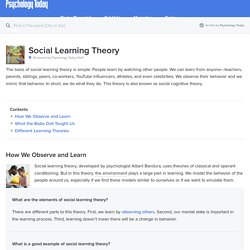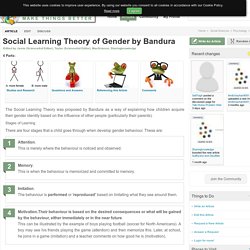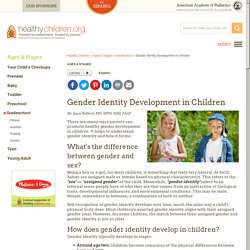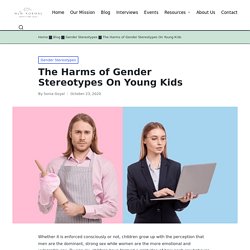

A Guide on Gender Equality for Kids. Boundless Psychology. Gender and Sociology From birth, children are assigned a gender and are socialized to conform to certain gender roles based on their biological sex. Learning Objectives Explain how gender roles shape individual behavior and how society punishes those who don’t conform Key Takeaways Key Points. Social Learning Theory in 4 Minutes □□□ How people learn from others □□□ Psychology. Social Learning Theory. Learning theory tells us how we take in and process information and knowledge.

A person’s environment influences his learning. In the case of Pavlov’s dog, for example, the physiologist Ivan Pavlov found that the sound of a metronome produced saliva in a dog’s mouth. Gender: social learning theory. Social Learning Theory in Children. There are many avenues to learning, but perhaps one of the most direct is simple observation.

Kids learn best by example, whether it’s a toddler imitating Mommy talking on the phone or a high schooler picking up new slang words from his friends. Social learning theory holds that people learn by observing the examples of those around them, both good and bad. General Principles Social learning theory focuses on learning that occurs within a social context, meaning that people learn from observing, imitating or modeling others. According to J.E. Social Learning Theory of Gender by Bandura - ScienceAid.
Edited by Jamie (ScienceAid Editor), Taylor (ScienceAid Editor), MaxScience, Sharingknowledge The Social Learning Theory was proposed by Bandura as a way of explaining how children acquire their gender identity based on the influence of other people (particularly their parents).

Stages of Learning. The Social Learning Theory Explanation for Gender Differences - HubPages. What is the Social Learning Theory's Ideas about Gender Differences?

The social learning theory or social learning approach also provides an insight into how and why gender differences arise. Unlike the biological approach, social learning theory suggests that our gender differences arise from our socialisation - our interactions with other human beings. Gender role. Some of the hats (roles) that we put on based on our biological gender: Gender roles and identity in children.
It’s common for people to think of the terms ‘sex’ and ‘gender’ as being the same, but they mean different things.

Someone’s sex refers to their physical biology: being male or female. A person’s gender identity, however, is a person’s sense of who they are – male, female, both or neither. Your gender identity is a deep sense of your own gender. In some cases, a person’s gender identity may be different from their biological sex. When do children become aware of their gender? Gender Roles In Children. This is what happens when gender roles are forced on kids. Story highlights A first-of-its-kind study looks at early adolescent gender identity development around the world Enforced gender expectations could lead to health inequities between boys and girls “This is Life with Lisa Ling” explores young people expanding beyond traditional gender binaries Sunday at 10 p.m.

Gender identity. Gender Identity and Expression in the Early Childhood Classroom: Influences on Development Within Sociocultural Contexts (Voices) Gender Identity Development in Children. By: Jason Rafferty MD, MPH, EdM, FAAP There are many ways parents can promote healthy gender development in children.

It helps to understand gender identity and how it forms. What's the difference between gender and sex? Exploring Gender Stereotypes with Children. Feminine Traits & Stereotypes. Our society has a set of ideas about how we expect men and women to dress, behave, and present themselves.

What are gender roles? Gender roles in society means how we’re expected to act, speak, dress, groom, and conduct ourselves based upon our assigned sex. The Harms of Gender Stereotypes On Young Kids – The New Normal. Whether it is enforced consciously or not, children grow up with the perception that men are the dominant, strong sex while women are the more emotional and vulnerable sex.

By age six, children have formed a rigid idea of how each sex behaves and how they should be treated (“Healthy Gender”). When puberty hits, the pressure to conform to these ideas influence the identity of these children (Grinberg). Starting at age two, children naturally start picking up on social cues and societal norms by observing the difference in interests of sexes and how each sex is treated (“Healthy Gender”). According to a new study done by the Journal of Adolescent Health, when kids mentally establish gender norms, behaving differently is “shunned out of fear of being ostracized” (Grinberg). Children's Gender Roles & Stereotypes.
Gender Stereotyping in the Early Years. Professor Cathy Nutbrown of the University of Sheffield discusses issues of gender stereotyping in early childhood settings… Gender stereotyping in children’s play in early years settings is a much-studied topic.

Gender identities – what it is to be a boy or a girl – are a strong feature of children’s play and often impact on their choices of types of play and playmates. Despite decades of thinking, and legislation, about gender equality, inequalities still remain for some men and women, and the effects of gender on young children’s learning can have implications for their future achievements. The Early Years Foundation Stage makes it clear that all children should have a wide range of opportunities to play and learn. It is important to challenge stereotypes early to give children a breadth of learning experiences. 5 Tips for Preventing and Reducing Gender Bias — Making Caring Common. 3. Help Kids Kick Stereotypes to the Curb Why.
Report 2 NFP Conference Helsinki Education abridged version. A Class That Turned Around Kids' Assumptions of Gender Roles! Youtube. Children on Gender Roles. (10) Gender Roles and Stereotypes. Gender stereotypes and education. Mom argues with child over gender appropriate toys. How Parents Influence Kids' Gender Roles. Healthy gender development.